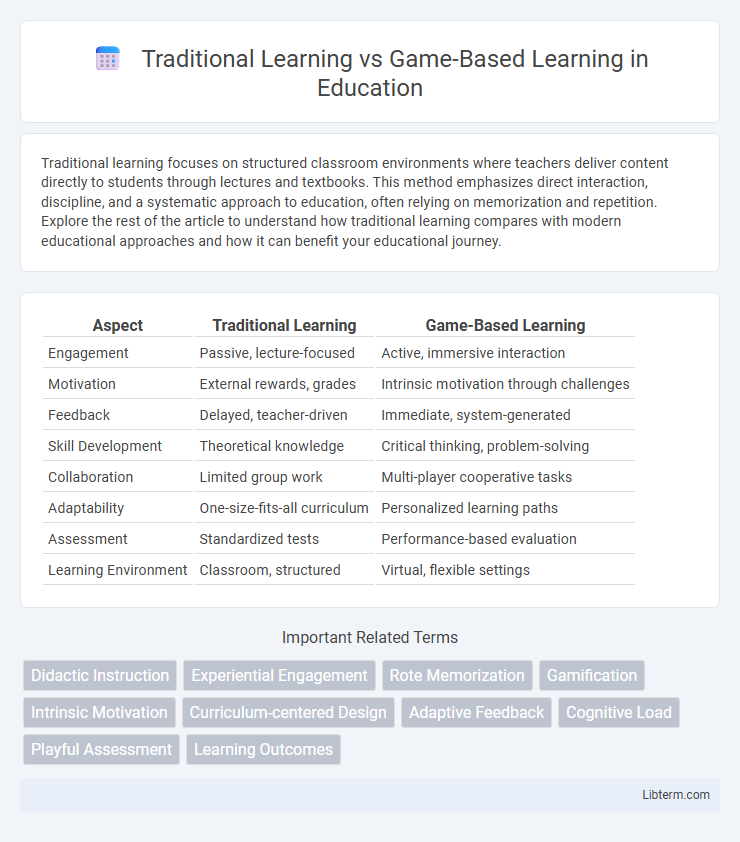Traditional learning focuses on structured classroom environments where teachers deliver content directly to students through lectures and textbooks. This method emphasizes direct interaction, discipline, and a systematic approach to education, often relying on memorization and repetition. Explore the rest of the article to understand how traditional learning compares with modern educational approaches and how it can benefit your educational journey.
Table of Comparison
| Aspect | Traditional Learning | Game-Based Learning |
|---|---|---|
| Engagement | Passive, lecture-focused | Active, immersive interaction |
| Motivation | External rewards, grades | Intrinsic motivation through challenges |
| Feedback | Delayed, teacher-driven | Immediate, system-generated |
| Skill Development | Theoretical knowledge | Critical thinking, problem-solving |
| Collaboration | Limited group work | Multi-player cooperative tasks |
| Adaptability | One-size-fits-all curriculum | Personalized learning paths |
| Assessment | Standardized tests | Performance-based evaluation |
| Learning Environment | Classroom, structured | Virtual, flexible settings |
Introduction to Traditional and Game-Based Learning
Traditional learning emphasizes structured, teacher-centered instruction with a focus on memorization, repetition, and passive absorption of information, often conducted in classroom settings using textbooks and lectures. Game-based learning integrates interactive digital or physical games into educational activities, promoting active engagement, problem-solving, and immediate feedback to enhance motivation and retention. Both methodologies aim to develop knowledge and skills, but game-based learning leverages immersive experiences to foster deeper cognitive connections and learner autonomy.
Key Differences Between Traditional and Game-Based Learning
Traditional learning relies on structured, instructor-led methods emphasizing passive information absorption, whereas game-based learning incorporates interactive, immersive experiences that promote active engagement and problem-solving skills. Key differences include the motivation source, with traditional learning often driven by external rewards like grades, while game-based learning uses intrinsic motivation through challenges and instant feedback. Assessment in traditional settings focuses on rote memorization and standardized testing, contrasting with game-based learning's dynamic evaluation through real-time progress and adaptive difficulty levels.
Benefits of Traditional Learning
Traditional learning provides a structured environment that promotes discipline, consistent knowledge acquisition, and the development of critical thinking skills through direct interaction with educators. It emphasizes foundational literacy and numeracy skills enhanced by face-to-face communication and immediate feedback. This method supports a reliable curriculum framework proven effective for standardized assessments and long-term academic success.
Advantages of Game-Based Learning
Game-based learning enhances student engagement by incorporating interactive elements and immediate feedback, promoting better retention and understanding of complex concepts. It fosters critical thinking, collaboration, and problem-solving skills through immersive scenarios and challenges, adapting to diverse learning styles. This method also increases motivation and participation by making education enjoyable and relevant, bridging the gap between theory and practical application.
Student Engagement: Which Method Excels?
Game-based learning significantly enhances student engagement by incorporating interactive elements, immediate feedback, and motivational challenges that traditional learning methods often lack. Studies show that students participating in game-based learning demonstrate higher attention spans and increased willingness to participate compared to those in traditional lecture-based environments. The immersive nature of game-based learning promotes active involvement, making it a superior approach for fostering sustained student engagement.
Impact on Knowledge Retention
Game-based learning significantly enhances knowledge retention by actively engaging students through interactive and immersive experiences, fostering deeper cognitive processing. Traditional learning methods often rely on passive information delivery, which can lead to lower retention rates due to limited student involvement. Research indicates that incorporating game mechanics such as immediate feedback, rewards, and challenges in educational settings boosts long-term memory retention and improves recall accuracy.
Adaptability to Different Learning Styles
Game-based learning demonstrates greater adaptability to different learning styles by incorporating interactive elements, visual stimuli, and immediate feedback, catering to kinesthetic, visual, and auditory learners alike. Traditional learning often relies on lectures and textbooks, which primarily support auditory and reading/writing preferences but may not engage learners who benefit from hands-on or experiential approaches. Studies show that game-based environments enhance motivation and retention by personalizing challenges and pacing, accommodating diverse cognitive needs more effectively than conventional classroom settings.
Challenges and Limitations of Each Approach
Traditional learning often faces challenges such as limited student engagement, passive knowledge absorption, and difficulty catering to diverse learning styles, which can hinder overall retention and motivation. Game-based learning, while enhancing interactivity and motivation, may struggle with issues like resource-intensive development, potential distraction from educational goals, and uneven access to technology among students. Both approaches require careful implementation to balance instructional effectiveness with student engagement and accessibility.
Best Practices for Integrating Both Methods
Effective integration of traditional learning and game-based learning involves aligning educational objectives with engaging, interactive game mechanics to enhance student motivation and retention. Implementing clear assessment criteria within game scenarios ensures measurable learning outcomes while maintaining alignment with curricular standards. Blending instructor-led discussions with immersive gameplay fosters critical thinking and collaboration, maximizing the benefits of both pedagogical approaches.
Future Trends in Educational Strategies
Future trends in educational strategies emphasize integrating game-based learning with traditional methods to enhance student engagement and retention. Adaptive learning technologies are increasingly used to personalize game-based experiences, making education more interactive and tailored to individual needs. Data analytics and AI-driven feedback within these platforms provide real-time assessment, supporting a shift toward competency-based education models.
Traditional Learning Infographic

 libterm.com
libterm.com